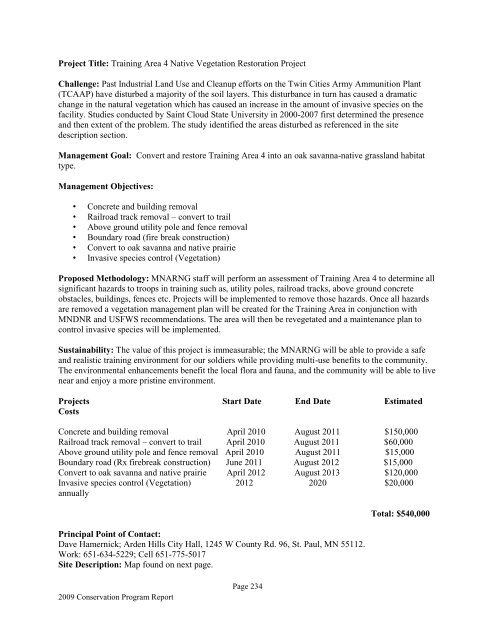camp ripley and arden hills minnesota army national guard training ...
camp ripley and arden hills minnesota army national guard training ...
camp ripley and arden hills minnesota army national guard training ...
You also want an ePaper? Increase the reach of your titles
YUMPU automatically turns print PDFs into web optimized ePapers that Google loves.
Project Title: Training Area 4 Native Vegetation Restoration Project<br />
Challenge: Past Industrial L<strong>and</strong> Use <strong>and</strong> Cleanup efforts on the Twin Cities Army Ammunition Plant<br />
(TCAAP) have disturbed a majority of the soil layers. This disturbance in turn has caused a dramatic<br />
change in the natural vegetation which has caused an increase in the amount of invasive species on the<br />
facility. Studies conducted by Saint Cloud State University in 2000-2007 first determined the presence<br />
<strong>and</strong> then extent of the problem. The study identified the areas disturbed as referenced in the site<br />
description section.<br />
Management Goal: Convert <strong>and</strong> restore Training Area 4 into an oak savanna-native grassl<strong>and</strong> habitat<br />
type.<br />
Management Objectives:<br />
• Concrete <strong>and</strong> building removal<br />
• Railroad track removal – convert to trail<br />
• Above ground utility pole <strong>and</strong> fence removal<br />
• Boundary road (fire break construction)<br />
• Convert to oak savanna <strong>and</strong> native prairie<br />
• Invasive species control (Vegetation)<br />
Proposed Methodology: MNARNG staff will perform an assessment of Training Area 4 to determine all<br />
significant hazards to troops in <strong>training</strong> such as, utility poles, railroad tracks, above ground concrete<br />
obstacles, buildings, fences etc. Projects will be implemented to remove those hazards. Once all hazards<br />
are removed a vegetation management plan will be created for the Training Area in conjunction with<br />
MNDNR <strong>and</strong> USFWS recommendations. The area will then be revegetated <strong>and</strong> a maintenance plan to<br />
control invasive species will be implemented.<br />
Sustainability: The value of this project is immeasurable; the MNARNG will be able to provide a safe<br />
<strong>and</strong> realistic <strong>training</strong> environment for our soldiers while providing multi-use benefits to the community.<br />
The environmental enhancements benefit the local flora <strong>and</strong> fauna, <strong>and</strong> the community will be able to live<br />
near <strong>and</strong> enjoy a more pristine environment.<br />
Projects Start Date End Date Estimated<br />
Costs<br />
Concrete <strong>and</strong> building removal April 2010 August 2011 $150,000<br />
Railroad track removal – convert to trail April 2010 August 2011 $60,000<br />
Above ground utility pole <strong>and</strong> fence removal April 2010 August 2011 $15,000<br />
Boundary road (Rx firebreak construction) June 2011 August 2012 $15,000<br />
Convert to oak savanna <strong>and</strong> native prairie April 2012 August 2013 $120,000<br />
Invasive species control (Vegetation) 2012 2020 $20,000<br />
annually<br />
Principal Point of Contact:<br />
Dave Hamernick; Arden Hills City Hall, 1245 W County Rd. 96, St. Paul, MN 55112.<br />
Work: 651-634-5229; Cell 651-775-5017<br />
Site Description: Map found on next page.<br />
2009 Conservation Program Report<br />
Page 234<br />
Total: $540,000
















